Why Sporks Exist

A spork is half spoon, half fork and completely weird. But behind its odd shape is a long history of practicality, military rations, fast food efficiency, and a quiet war against dishwashing.
What Is a Spork?
A spork is exactly what it sounds like: a hybrid utensil combining the scoop of a spoon with the prongs of a fork. It’s designed to help people eat both liquids and solids with a single tool. It’s often made of plastic, but you’ll find metal, bamboo, and even titanium sporks sold as camping gear or minimalist dining solutions.
A Brief History of the Spork
The earliest patent resembling a spork dates back to the late 1800s, credited to U.S. inventor Samuel W. Francis.
The word “spork” itself didn’t show up in dictionaries until the 1960s.
Its popularity skyrocketed in the 1980s and 1990s thanks to fast food restaurants, school cafeterias, and military rations (MREs).
The U.S. Army and various airline meal trays began using sporks because it reduced waste, weight, and washing.
Why Do We Actually Use Sporks?
One Tool to Rule Them All
Sporks are efficient. You don’t need to hand out a spoon and a fork. One utensil handles soup, salad, pasta, and pudding.
Perfect for Takeout & Cafeterias
Sporks cut costs. Less plastic. Less packaging. Fewer things to throw away.
Minimalist Approved
Hikers, campers, and backpackers love sporks for their simplicity. No need to carry an entire utensil set on the trail.
Sporks Save Time… and Soap
When used in cafeterias or by food delivery services, sporks reduce the need for washing, stocking, and sorting different utensils. In food service, that saves money and time, especially in high-volume settings. Also: less plastic waste from giving out multiple utensils. Even if it’s still single-use, it’s less single-use.
Final Scoop
The spork may not win any culinary awards, but it’s a brilliantly practical invention that solves a very real problem: how to eat mac and cheese and soup with one hand while on the move.
Sources: